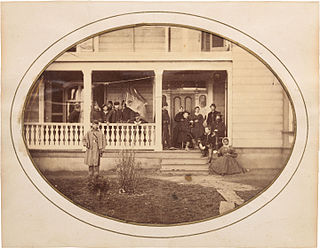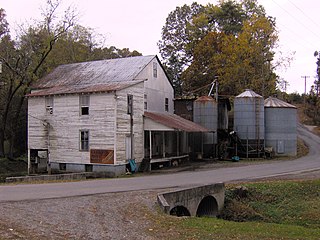
Clover or trefoil are common names for plants of the genus Trifolium, consisting of about 300 species of flowering plants in the legume or pea family Fabaceae. The genus has a cosmopolitan distribution with highest diversity in the temperate Northern Hemisphere, but many species also occur in South America and Africa, including at high altitudes on mountains in the tropics. They are small annual, biennial, or short-lived perennial herbaceous plants. Clover can be evergreen. The leaves are trifoliate, cinquefoil, or septfoil), with stipules adnate to the leaf-stalk, and heads or dense spikes of small red, purple, white, or yellow flowers; the small, few-seeded pods are enclosed in the calyx. Other closely related genera often called clovers include Melilotus and Medicago.

The Appomattox Courthouse is the current courthouse in Appomattox, Virginia built in 1892. It is located in the middle of the state about three miles (5 km) southwest of the Appomattox Court House National Historical Park, once known as Clover Hill—home of the original Old Appomattox Court House. The "new" Appomattox Courthouse is near the Appomattox Station and where the regional county government is located.

The Appomattox Court House is a National Historical Park of original and reconstructed 19th century buildings in Appomattox County, Virginia. The village is famous as the site of the Battle of Appomattox Court House and containing the house of Wilmer McLean, where the surrender of the Confederate army under Robert E. Lee to Union commander Ulysses S. Grant took place on April 9, 1865, effectively ending the American Civil War. The McLean House was the site of the surrender conference, but the village itself is named for the presence nearby of what is now preserved as the Old Appomattox Court House.

The four-leaf clover is a rare variation of the common three-leaf clover. According to traditional superstition, such clovers bring good luck, though it is not clear when or how that superstition got started. The earliest mention of "Fower-leafed or purple grasse" is from 1640 and simply says that it was kept in gardens because it was "good for the purples in children or others". A description from 1869 says that four-leaf clovers were "gathered at night-time during the full moon by sorceresses, who mixed it with vervain and other ingredients, while young girls in search of a token of perfect happiness made quest of the plant by day". The first reference to luck might be from an 11-year-old girl, who wrote in an 1877 letter to St. Nicholas Magazine, "Did the fairies ever whisper in your ear, that a four-leaf clover brought good luck to the finder?"
The Tule Desert is located in southeastern Nevada in Lincoln County, near the Utah state line. The desert lies northeast of the Mormon Mountains, south of the Clover Mountains and west of the Tule Springs Hills.
Clover Creek is a 24.5-mile-long (39.4 km) tributary of the Frankstown Branch Juniata River in Bedford and Blair counties, Pennsylvania, in the United States.

A good luck charm is an amulet or other item that is believed to bring good luck.

The Cloverly Formation is a geological formation of Early Cretaceous age that is present in parts of Montana, Wyoming, Colorado and Utah in the western United States. It was named for a post office on the eastern side of the Bighorn Basin in Wyoming by N.H. Darton in 1904. The sedimentary rocks of formation were deposited in floodplain environments and contain vertebrate fossils, including a diverse assemblage of dinosaur remains. In 1973, the Cloverly Formation Site was designated as a National Natural Landmark by the National Park Service.

Clover Hill High School is a public secondary school located in Midlothian, an unincorporated community in Chesterfield County, Virginia, United States. It is part of Chesterfield County Public Schools and is located at 13301 Kelly Green Lane. The school opened in 1972 and moved to its present location in 2010.

The Clover Hill Tavern with its guest house and slave quarters are structures within the Appomattox Court House National Historical Park. They were registered in the National Park Service's database of Official Structures on June 26, 1989.
Clover Hill or Clover Hill Historic District may refer to:

Clover Hill is a decaying 18th-century plantation house near Culpeper in Culpeper County, Virginia. Clover Hill is best known for serving as the headquarters for Brigadier General George Armstrong Custer during the American Civil War. Clover Hill was home to James Barbour, a prominent American lawyer, planter, delegate from Virginia to the 1860 Democratic National Convention, delegate to the 1861 Virginia secession convention, and a major in the Confederate States Army during the American Civil War.

The Clover Hill Mill is a gristmill located in the U.S. city of Maryville, Tennessee. Out of the hundreds of early-20th century mills once scattered across the mountains of East Tennessee, the Clover Hill Mill is one of the few still in operation, and the last such full service mill in Blount County. The mill was added to the National Register of Historic Places in 1989.

Clover Hill is an unincorporated community in Albemarle County, Virginia.

Clover Hill is an unincorporated community located in Coahoma County, Mississippi. Clover Hill is approximately 4 miles (6.4 km) north of Lyon and approximately 4 miles (6.4 km) south of Rudyard.

Clover Hill is one of the 20 electoral wards that form the Parliamentary constituency of Pendle, Lancashire, England. The ward returns three councillors to represent the Clover Hill area of Nelson on Pendle Borough Council. The incumbent councillors are Eileen Ansar, Kathleen Shore and Wayne Blackburn, all of the Labour Party. As of the May 2011 Council election, Clover Hill had an electorate of 3,782.

Clover is a 1997 TV-movie that first aired on USA with Elizabeth McGovern, Ernie Hudson, Zelda Harris and Beatrice Winde based on Dori Sanders' bestselling 1990 novel Clover.

Cloverhill or Clover Hill is an unincorporated community located at the intersection of the boundaries of East Amwell and Raritan townships in Hunterdon County and Hillsborough Township in Somerset County, in New Jersey, United States. It was added to the National Register of Historic Places in 1980.

Black Clover is a Japanese manga series written and illustrated by Yūki Tabata. It has been serialized in Shueisha's Weekly Shōnen Jump magazine since February 16, 2015, and has been collected into 20 tankōbon volumes. The story centers around Asta, a young boy seemingly born without any magic power, something that is unknown in the world he lives in. With his fellow mages from the Black Bulls, Asta plans to become the next Wizard King.

The Clover Hill Railroad was a railroad company that operated for 36 years in central Virginia near Richmond. The railroad was created to carry coal most efficiently from the Clover Hill Pits in Winterpock, Virginia, to further transportation points in Chester, Virginia, where it could sold for a better price than on the Appomattox River in the Piedmont region. This made the railroad important to the Confederacy in the Civil War to ensure a supply of coal for munitions and iron working. The mines were dangerous for the miners, and many accidents occurred. The railroad had to be sold when coal mining declined so that new owners could find other uses for the railroad.





















